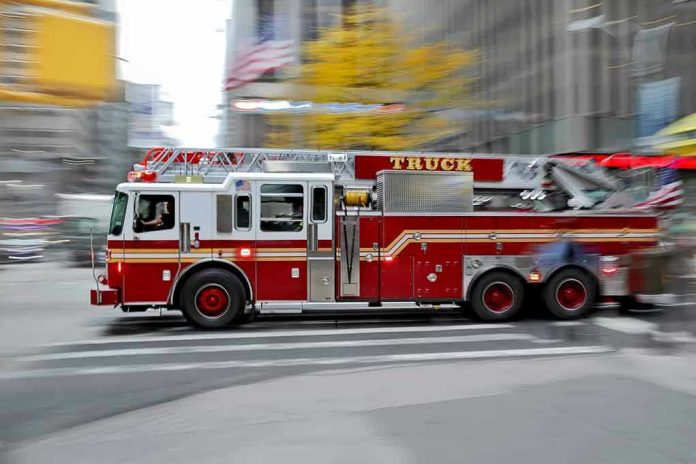
Twenty souls perished in minutes—locked inside a brand-new bus as flames devoured their only exit—leaving India to confront a question it can’t ignore: How safe are its roads, really?
Story Snapshot
- A new passenger bus in Rajasthan erupted in flames, killing at least 20 and injuring over a dozen.
- A jammed main door trapped victims, amplifying the tragedy and raising urgent safety questions.
- Prime Minister Modi responded with compensation, while forensic teams scrambled for victim identification.
- The disaster has reignited scrutiny of India’s chronic road safety failures and regulatory enforcement.
When a Routine Journey Turns Deadly: The Jaisalmer-Jodhpur Bus Fire
A bus newly minted for the open highways of Rajasthan became a steel coffin. Passengers bound from Jaisalmer to Jodhpur barely had time to react when smoke crept from the rear. The driver veered to a halt, but a simple defect—a jammed door—rendered escape impossible for many. In the chaos, fire raced through the vehicle. By the time local responders arrived, the toll had already reached 20 dead, with at least 15 more hospitalized for burns. The bus, just days into service, offered no protection from a technical failure that proved instantly fatal.
As the fire’s aftermath settled, the horror was compounded by the need for forensic teams to identify bodies burned beyond recognition. National leaders responded with swift statements and compensation pledges. Yet, for grieving families, the official gestures could not mask a deeper wound: trust shattered in both technology and oversight.
Technical Failure Meets Systemic Lapse: Why Did So Many Die?
This was not an ancient, neglected vehicle limping along a dusty road. Reports confirm the bus was recently acquired, theoretically equipped with the latest safety technology. Investigators suspect an electrical short circuit as the fire’s spark, but the true villain may be apathy toward maintenance and emergency protocols. The jammed door was not an act of fate—it was a foreseeable risk, ignored until it became irreversible fact. Survivors and witnesses described frantic attempts to break windows, their efforts hampered by the speed of the flames and the panic of those trapped inside.
Such heart-stopping failures are not isolated in India’s transport history. A 2013 Andhra Pradesh bus fire killed 45. A 2023 Maharashtra blaze took 25 lives. Each time, the pattern repeats: technical malfunction, human error, regulatory blindness, followed by national soul-searching and promises of reform that fade with the news cycle. The Rajasthan tragedy stands out only because the bus’s newness should have been a guarantee, not a gamble.
At least 20 people dead as passenger bus catches fire in northern India https://t.co/ZGsaiKZ1JT pic.twitter.com/fLz2HDG0yL
— The Independent (@Independent) October 15, 2025
Blame, Accountability, and the National Response
Official reaction was immediate. Prime Minister Narendra Modi issued condolences within hours, promising ₹200,000 for the families of the deceased and ₹50,000 for those injured. Local officials cited the jammed exit as a primary cause of the high death toll, echoing frustrations long voiced by transport safety advocates. The bus operator faces investigation; the manufacturer’s reputation is now part of the inquiry. Forensic teams, more commonly associated with crime scenes, have become an expected presence at scenes of public transport disaster across India.
Victims’ families demand more than compensation—they want accountability, and assurances that future travelers will not face the same fate. The government and law enforcement wield authority over the investigation, but the public’s trust hangs in the balance. The media’s relentless coverage ensures that the pressure for reform, at least temporarily, will not abate.
India’s Road Safety Reckoning: Will Anything Change?
For decades, India’s highways have been economic lifelines and sites of recurring tragedy. Expansion of intercity bus services has been lauded as progress, yet safety standards consistently lag. Industry experts warn that rapid growth, if not matched by rigorous enforcement of maintenance and emergency protocols, will continue to make every journey a risk. Academics and professionals point to systemic failures: lack of regular safety audits, poor driver training, and toothless penalties for violations.
The Rajasthan fire forced a reckoning—at least for now. The incident has reignited calls for policy overhauls, stricter inspections, and public pressure on both operators and regulators. Tourism, a vital sector for Rajasthan, now grapples with shaken confidence. The economic and social costs will extend far beyond the immediate loss of life. As the investigation grinds forward, the haunting question remains: will this latest tragedy be the catalyst for real change, or will it become just another entry in India’s growing ledger of preventable disasters?













